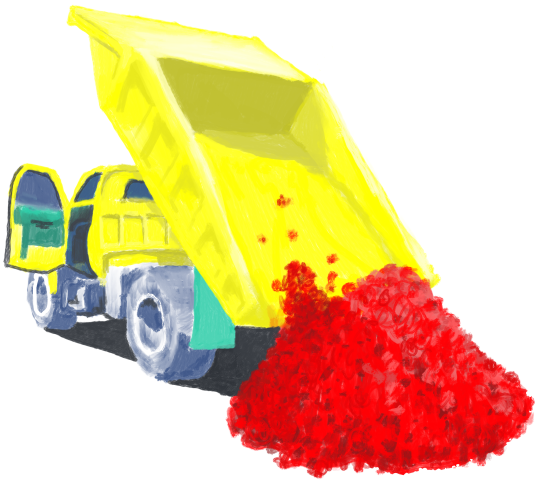Why Plan?
Which would be better? Should a husband give his wife a giant truck load of roses just once in their marriage? Or a steady stream of romantic moments throughout the marriage with each punctuated with a single rose? I hope for your sake you find the question rhetorical! In the same way that it's healthier to spread out your meals, sleeping, work, play, etc., so should you pace your postings. Consistency is a major factor in retaining and engaging web site visitors. They’d rather see a weekly posting instead of 52 postings all-at-once followed by 51 weeks of silence.
Consequently, I'm using a spreadsheet to capture ideas for future posts, to track their creation and development, and to schedule when each will be published. I wanted to share that creator’s tool with you, so let’s start by looking at each attribute (column) in my spreadsheet. You’ll also find a link to an example spreadsheet, that you can use for your own template, at the end of this article.
Click to magnify: My Google Docs spreadsheet for planning posts
The Attributes
- ITEM: The article title or topic
- TIMELY?: Is the post related to a date or deadline in any way? For example, an announcement or a status update should be posted in proximity to the event it discusses. While a product review or tutorial doesn’t necessarily have to be posted as soon as it is completed. The timeliness attribute has a major bearing on the priority of an item, both in terms of when it gets posted and what I work on first if I'm trying to make a due date. The deadline itself goes in the POST column.
- SEQ: Once I determine an item’s priority, I record the sequence in which they will be created and posted. Any row without a sequence assignment stands out and serves as a To-Do reminder that I need to complete its evaluation and make a decision. The sequence number represents priority in ascending order, so 1 (one) would be my number one priority. Sequence numbers do not have to be consecutive or unique. For example, I could have several items with a sequence of 99 to show they are all low priority. Assign values in steps of 10 so you'll have slots to insert items later (e.g., 10, 20, 30, 40, etc.). After an article has been posted, I change this value to zero and give that row a gray background to show it has been completed. And speaking of colors, throughout the spreadsheet I use highlighting and font color to draw my eye to outstanding tasks.
- READY? This column identifies if an item is ready for posting. A value of “awaiting” means an item is finished, but the posting date is dependent on some external factor. The explanation for what I’m waiting on will be in the NOTES column. Otherwise I put “YES” if it's ready to be posted or scheduled or blank (which stands out better than putting “no”) or “POSTED.”
- POST ON: This is the date when an item is to be posted. If it is relative to some other factor, then I put “TBD” and explain the dependency in the NOTES column. A value of “dry week” indicates an item that can be posted at any time and is suitable when there aren’t more pressing items taking priority.
- There are tools you can use to schedule the actual postings. For example, Squarespace’s blog/news postings can be scheduled, Twitter’s TweetDeck, or multi-site Buffer.com. The latter has a scaled-down free version. I’d previously used Hootsuite but found it limited and unstable (e.g., can only post to Google+ pages—not profiles and image gets dropped from Facebook postings), so I recently switched to Buffer. Both offer a free personal version, and the paid versions aren’t cheap. But if your site is busy enough to warrant those premium features, then it is probably generating enough traffic and income to justify. Until then, you could use a spreadsheet to keep track of when you need to perform cross-posting announcements (like below). Set a reminder alarm for the next date and time. When it rings, navigate to the service listed in the SITE column. Then copy and paste the EXCERPT and URL into the posting. Delete that row, and change your reminder for the next date and time.
- There are many conflicting studies regarding the best time of day and day of the week to post for maximum impact. Your audience and their timezone plays a big role, but with a heavy bias in the Eastern Time Zone. Below is my personal guestimation that I cobbled together from a few different sources. The letters represent good time slots for Facebook, Twitter, Instagram, Pinterest, LinkedIn, and Google+ (with optimal windows in red). Consequently, I moving my web postings from Mondays to Wednesdays since most social sites share a window during that day.
| MON | TUE | WED | THU | FRI | SAT | SUN | |
| 0800 | L | L | L | ||||
| 0900 | G | G | G | G | |||
| 1000 | G | G,L | G | G | |||
| 1100 | |||||||
| 1200 | T,I | T,L,I | T,L,I | T,L,I | I | F | F |
| 1300 | T | T | T | T,F | T,F | F | F |
| 1400 | T | T | T | T,F | T,F | F | F |
| 1500 | T | T | T,F | T,F | T,F | F | F |
| 1600 | |||||||
| 1700 | T,L,I | T,L,I | T,L,I | T,L,I | T,I | ||
| 1800 | |||||||
| 1900 | |||||||
| 2000 | P | ||||||
| 2100 | P | P | |||||
| 2200 | P |
- Services: The next few columns list the services and social sites where announcements and cross-posting links are planned. For example, after completing an art project and posting all the related images on the web site, I'd make an announcement in my NEWS feed (blog). Although the project page may have many photos of the work in progress, the finished image is the main graphic. So, I’d want to post that photo on Instagram and Pinterest as well. I use “YES” (uppercase) and "no" (lowercase) to record my decision. The “YES” values also serve as a checklist of assets to be created (e.g., a square image for Instagram, a portrait image for Pinterest, and/or a highly-condensed excerpt for Twitter). And the READY? column will track if they’ve all been completed yet.
- Google and tumblr (since I always post to the other if I post to the one)
- LinkedIn (for items that may have an interest to the business community)
- Instagram (for items that have a visual element)
- Pinterest (for items that have a visual element)
- Facebook
- NOTES: Any dependencies or clarifications are recorded here
- CATS & TAGS: The category and tags for the topic. They serve as a reminder to add them to the social media post. And they help balance and vary postings to keep the news feed fresh. For example, if the last two postings were about art, I could pick a different category for my next posting.
- Within this spreadsheet is a “Cats & Tags” page where I keep track of all my category and tags to ensure consistency. I will reference this list to identify which of them apply to a newly written article. And I update and supplement the list based on how readers might be searching for those topic. For example, an article about writing would obviously get a tag of #writing. But my list has a note reminding me that on Twitter users search for #writingtips more than for #writing. So my announcement post about my new article on Twitter would use #writingtips.
- Within this spreadsheet is a “Cats & Tags” page where I keep track of all my category and tags to ensure consistency. I will reference this list to identify which of them apply to a newly written article. And I update and supplement the list based on how readers might be searching for those topic. For example, an article about writing would obviously get a tag of #writing. But my list has a note reminding me that on Twitter users search for #writingtips more than for #writing. So my announcement post about my new article on Twitter would use #writingtips.
- URL: For copy & pasting convenience
- CHARS: A formula that calculates the number of characters in the Excerpt column
- EXCERPT: The hook that explains what the reader will get if they follow the link in the post
If you have a more formal workflow, you could add columns to track tasks with greater granularity. For example, for text-centric posts you could add a WRITE column with the values of blank (an idea yet to be started), “Research,” “Draft,” “Edit,” or “Done.” In a team environment, assignee names could be used beneath various columns. But as you customize a posting planner that fits your needs, beware of the trap of tracking too many attributes. Only track what actively helps you:
- Stay on track
- Prevent omissions
- Create quality
- Deliver consistently
I leave you with one final benefit of pacing out your posts. It’s always good to let a piece simmer for awhile. So when you return and give it one more review before publishing (which you should!), then it’s with a fresh perspective. That can surface issues you were previously blind to, and recharge your creativity so your edits have more punch and polish.
An example spreadsheet is available for public access on Google Docs. You can click the button below to view it. You can copy this example to create your own editable version which you can enhance and modify to meet your specific needs.



